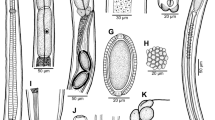Abstract
Introduction
Pseudocapillaria (Ichthyocapillaria) bumpi n. sp. (Nematoda: Capillariidae) is described from specimens infecting the digestive tract of the West African lungfish, Protopterus annectens (Owen) (Lepidosireniformes: Protopteridae).
Methods
Nematodes were collected in Karingani Game Reserve, Southern Mozambique and studied using light microscopy; obtained sequences of the 18S ribosomal (18S rRNA) gene used for phylogenetic studies.
Results
The new species is assigned to Pseudocapillaria Freitas, 1959 by having a stichosome consisting of a single row of stichocytes and ventrolateral lobes on the male tail as well as by lacking spines on the specular sheath, caudal alae, a membranous caudal bursa, and a lateral expansion of the caudal end. It is also assigned to the sub-genus Ichthyocapillaria Moravec, 1982 by having a membrane between the ventrolateral lobes and by lacking a vulvar appendage. Pseudocapillaria (I.) bumpi n. sp. differs from its nominal congeners by having a comparatively large body size with relatively long spicule, bearing the thin membrane non-extending further than ventrolateral lobes in males and relatively smaller eggs without protruding polar plugs. It is the 20th species of the genus, the first from the Afrotropical Realm, and the first from any lungfish species. Phylogenetic analyses suggested that P. (I.) bumpi is deeply nested in a clade that associates species of the genera Pearsonema, Aonchotheca and Baruscapillaria.




Similar content being viewed by others
References
Moravec F (2001) Trichinelloid nematodes parasitic in cold-blooded vertebrates. Academia, Prague, p 430. https://doi.org/10.14411/fp.2002.007
Moravec F, Beveridge I (2007) Lobocapillaria austropacifica n. g. n. sp. (Nematoda: Capillariidae) from the obtuse barracuda Sphyraena obtusata Cuvier (Sphyraenidae, Perciformes) off eastern Australia. Syst Parasitol 94(5):547–556. https://doi.org/10.1007/s11230-017-9722-8
Gibbons L (2010) Keys to the nematode parasites of vertebrates. Supplementary volume. CAB International, Oxon, p 416. https://doi.org/10.1079/9781845935719.0003
Fritsch G (1886) Die Parasiten des Zitterwelses. Sitzungsberichte der Akademie der Wissenschaften zu Berlin 6:99–108
Tadros G, Mahmoud M (1968) On Capillaria yamagutii sp. nov. (Nematoda: Trichuridae) from the Nile fish Bagrus bayad. J Vet Sci UAR 5:133–142
Moravec F (1974) On some nematodes from Egyptian freshwater fishes. Acta Soc Zool Bohemoslov 38:32–51
Campana-Rouget Y (1961) Nématodes de poissons. Résultats Scientifiques de l’Exploration Hydrobiologique. Lacs Kivu, Édouard et Albert (1952–1954). Bruxelles 3:1–61
Moravec F, Scholtz T (2017) Some nematodes, including two new species, from freshwater fishes in the Sudan and Ethiopia. Folia Parasitol 64:010. https://doi.org/10.14411/fp.2017.010
Moravec F, Jirků M (2017) Some nematodes from freshwater fishes in central Africa. Folia Parasitol 64:033. https://doi.org/10.14411/fp.2017.033
Omeji S, Obane RA, Solomon SG (2017) Morphological and parasitological variations of African lungfish Protopterus annectens in dry and rainy seasons. J Res For Wildl Environ 9:104–113
Schoeman A, Joubert T, Du Preez L, Svitin R (2020) Xenopus laevis as UberXL for nematodes. Afr Zool 55:7–24. https://doi.org/10.1080/15627020.2019.1681295
Hobbs R, Hassan M (2010) Pseudocapillaria (Ichthyocapillaria) nannupensis n. sp. (Nematoda: Capillariidae) from the intestine of the freshwater cobbler Tandanus bostocki (Plotosidae) from Southwestern Australia. Comp Parasitol 77:20–24. https://doi.org/10.1654/4390.1
Tamaru M, Yamaki S, Jimenez LA, Sato H (2015) Morphological and molecular genetic characterization of three Capillaria spp. (Capillaria anatis, Capillaria pudendotecta, and Capillaria madseni) and Baruscapillaria obsignata (Nematoda: Trichuridae: Capillariinae) in avians. Parasitol Res 114:4011–4022. https://doi.org/10.1007/s00436-015-4629-2
Sakaguchi S, Yunus M, Sugi S, Sato H (2019) Integrated taxonomic approaches to seven species of capillariid nematodes (Nematoda: Trichocephalida: Trichinelloidea) in poultry from Japan and Indonesia, with special reference to their 18S rDNA phylogenetic relationships. Parasitol Res 119:957–972. https://doi.org/10.1007/s00436-019-06544-y
Rambaut A (2012) FigTree v. 1.4. Molecular evolution, phylogenetics and epidemiology. Edinburgh, UK: University of Edinburgh, Institute of Evolutionary Biology. http://tree.bio.ed.ac.uk/software/figtree/
Moravec F (2019) Parasitic nematodes of freshwater fishes of Africa. Academia, Praha, p 406
Skelton P (1993) A complete guide to the freshwater fishes of Southern Africa. Southern Book Publishers, p 388
Acknowledgements
We thank Mr Elery Worth (Manager of Karingani Game Reserve) for providing the permissions, facilities, vehicles, and personnel to help collect hosts and parasites. We also thank Professor Frantisek Moravec (Institute of Parasitology of the Czech Academy of Sciences) for kindly granted copies of his publications. Funding for this work was provided by North-West University (Potchefstroom, South Africa) and by Auburn University’s Office of the Vice President for Research and Economic Development, the Southeastern Cooperative Fish Parasite and Disease Project (Alabama Department of Conservation and Natural Resources), and the Alabama Agriculture Experiment Station.
Author information
Authors and Affiliations
Corresponding author
Ethics declarations
Ethical approval
All applicable institutional, national and international guidelines for the care and use of animals were followed. North-West University ethics approval no NWU-00380-16-A5.
Additional information
Publisher's Note
Springer Nature remains neutral with regard to jurisdictional claims in published maps and institutional affiliations.
Rights and permissions
About this article
Cite this article
Svitin, R., Bullard, S., Dutton, H. et al. Pseudocapillaria (Ichthyocapillaria) bumpi n. sp. (Nematoda: Capillariidae) Parasitising West African Lungfish Protopterus annectens (Owen, 1839) (Lepidosireniformes: Protopteridae) in Mozambique and Its Phylogenetic Position Within Capillariid Nematodes. Acta Parasit. 66, 1204–1211 (2021). https://doi.org/10.1007/s11686-021-00389-1
Received:
Accepted:
Published:
Issue Date:
DOI: https://doi.org/10.1007/s11686-021-00389-1




